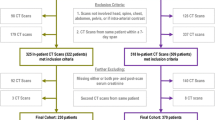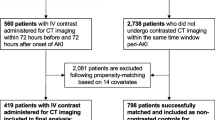Abstract
Background
Contrast-induced acute kidney injury (CI-AKI) is a common pathology among adult patients, with an incidence ranging from 3–25 % depending on risk factors. Little information is available regarding CI-AKI incidence, risk factors, and prognostic impact in the pediatric population.
Methods
We performed a retrospective study of pediatric patients who underwent computed tomography (CT) scan with iodinated contrast media injection between 2005 and 2014 in five pediatric units of a university hospital. CI-AKI was defined according to Kidney Disease/Improving Global Outcomes (KDIGO) criteria.
Results
Of 346 identified patients, 233 had renal function follow-up and were included in our analyses. CI-AKI incidence was 10.3 % [95 % confidence interval (CI) 6.4–14.2 %]. CI-AKI was associated with 30-day unfavorable outcome before (45.8 % vs. 19.7 %, P = 0.007) and after [odds ratio (OR) 3.6; 95 % CI 1.4–9.5] adjustment for confounders. No independent risk factors of CI-AKI were identified.
Conclusions
CI-AKI incidence was as high as 10.3 % following intravenous contrast media administration in the pediatric setting. As reported among adults, CI-AKI was associated with unfavorable outcome after adjustment for confounders. Although additional studies are needed in the pediatric setting, our data suggest that physicians should maintain a high degree of suspicion toward this complication among pediatric patients.


Similar content being viewed by others
References
Joannidis M, Metnitz B, Bauer P, Schusterschitz N, Moreno R, Druml W, Metnitz PGH (2009) Acute kidney injury in critically ill patients classified by AKIN versus RIFLE using the SAPS 3 database. Intensive Care Med 35:1692–1702
Nisula S, Kaukonen KM, Vaara ST, Korhonen AM, Poukkanen M, Karlsson S, Haapio M, Inkinen O, Parviainen I, Suojaranta-Ylinen R, Laurila JJ, Tenhunen J, Reinikainen M, Ala-Kokko T, Ruokonen E, Kuitunen A, Pettilä V, FINNAKI Study Group (2013) Incidence, risk factors and 90-day mortality of patients with acute kidney injury in Finnish intensive care units: the FINNAKI study. Intensive Care Med 39:420–428
Stads S, Fortrie G, van Bommel J, Zietse R, Betjes MGH (2013) Impaired kidney function at hospital discharge and long-term renal and overall survival in patients who received CRRT. Clin J Am Soc Nephrol 8:1284–1291
Hoste EAJ, Schurgers M (2008) Epidemiology of acute kidney injury: How big is the problem? Crit Care Med 36:S146–S151
Li X, Hassoun HT, Santora R, Rabb H (2009) Organ crosstalk: the role of the kidney. Curr Opin Crit Care 15:481–487
Metnitz PGH, Krenn CG, Steltzer H, Lang T, Ploder J, Lenz K, Le Gall J-R, Druml W (2002) Effect of acute renal failure requiring renal replacement therapy on outcome in critically ill patients. Crit Care Med 30:2051–2058
Liu M, Liang Y, Chigurupati S, Lathia JD, Pletnikov M, Sun Z, Crow M, Ross CA, Mattson MP, Rabb H (2008) Acute kidney injury leads to inflammation and functional changes in the brain. J Am Soc Nephrol 19:1360–1370
Rich MW, Crecelius CA (1990) Incidence, risk factors, and clinical course of acute renal insufficiency after cardiac catheterization in patients 70 years of age or older. A prospective study. Arch Intern Med 150:1237–1242
Nash K, Hafeez A, Hou S (2002) Hospital-acquired renal insufficiency. Am J Kidney Dis 39:930–936
Goldenberg I, Matetzky S (2005) Nephropathy induced by contrast media: pathogenesis, risk factors and preventive strategies. CMAJ 172:1461–1471
Waikar SS, Bonventre JV (2009) Creatinine kinetics and the definition of acute kidney injury. J Am Soc Nephrol 20:672–679
Khwaja A (2012) KDIGO clinical practice guidelines for acute kidney injury. Nephron Clin Pract 120:179–184
Kellum JA, Lameire N, KDIGO AKI Guideline Work Group (2013) Diagnosis, evaluation, and management of acute kidney injury: a KDIGO summary (Part 1). Crit Care 17:204
Rihal CS, Textor SC, Grill DE, Berger PB, Ting HH, Best PJ, Singh M, Bell MR, Barsness GW, Mathew V, Garratt KN, Holmes DR Jr (2002) Incidence and prognostic importance of acute renal failure after percutaneous coronary intervention. Circulation 105:2259–2264
Rudnick MR, Goldfarb S, Tumlin J (2008) Contrast-induced nephropathy: is the picture any clearer? Clin J Am Soc Nephrol 3:261–262
Zo’o M, Hoermann M, Balassy C, Brunelle F, Azoulay R, Pariente D, Panuel M, Le Dosseur P (2011) Renal safety in pediatric imaging: randomized, double-blind phase IV clinical trial of iobitridol 300 versus iodixanol 270 in multidetector CT. Pediatr Radiol 41:1393–1400
Selewski DT, Cornell TT, Heung M, Troost JP, Ehrmann BJ, Lombel RM, Blatt NB, Luckritz K, Hieber S, Gajarski R, Kershaw DB, Shanley TP, Gipson DS (2014) Validation of the KDIGO acute kidney injury criteria in a pediatric critical care population. Intensive Care Med 40:1481–1488
Schwartz GJ, Work DF (2009) Measurement and estimation of GFR in children and adolescents. Clin J Am Soc Nephrol 4:1832–1843
Levy MM, Fink MP, Marshall JC, Abraham E, Angus D, Cook D, Cohen J, Opal SM, Vincent J-L, Ramsay G (2003) 2001 SCCM/ESICM/ACCP/ATS/SIS international sepsis definitions conference. Intensive Care Med 29:530–538
Moore RD, Steinberg EP, Powe NR, Brinker JA, Fishman EK, Graziano S, Gopalan R (1992) Nephrotoxicity of high-osmolality versus low-osmolality contrast media: randomized clinical trial. Radiology 182:649–655
D’Elia JA, Gleason RE, Alday M, Malarick C, Godley K, Warram J, Kaldany A, Weinrauch LA (1982) Nephrotoxicity from angiographic contrast material. A prospective study. Am J Med 72:719–725
Lautrette A, Phan T-N, Ouchchane L, Aithssain A, Tixier V, Heng A-E, Souweine B (2012) High creatinine clearance in critically ill patients with community-acquired acute infectious meningitis. BMC Nephrol 13:124
De Cock PAJG, Standing JF, Barker CIS, de Jaeger A, Dhont E, Carlier M, Verstraete AG, Delanghe JR, Robays H, De Paepe P (2015) Augmented renal clearance implies a need for increased Amoxicillin-Clavulanic acid dosing in critically Ill children. Antimicrob Agents Chemother 59:7027–7035
Linder A, Fjell C, Levin A, Walley KR, Russell JA, Boyd JH (2014) Small acute increases in serum creatinine are associated with decreased long-term survival in the critically ill. Am J Respir Crit Care Med 189:1075–1081
Greenberg JH, Coca S, Parikh CR (2014) Long-term risk of chronic kidney disease and mortality in children after acute kidney injury: a systematic review. BMC Nephrol 15:184
Schneider J, Khemani R, Grushkin C, Bart R (2010) Serum creatinine as stratified in the RIFLE score for acute kidney injury is associated with mortality and length of stay for children in the pediatric intensive care unit. Crit Care Med 38:933–939
Alkandari O, Eddington KA, Hyder A, Gauvin F, Ducruet T, Gottesman R, Phan V, Zappitelli M (2011) Acute kidney injury is an independent risk factor for pediatric intensive care unit mortality, longer length of stay and prolonged mechanical ventilation in critically ill children: a two-center retrospective cohort study. Crit Care 15:R146
Mammen C, Al Abbas A, Skippen P, Nadel H, Levine D, Collet JP, Matsell DG (2012) Long-term risk of CKD in children surviving episodes of acute kidney injury in the intensive care unit: a prospective cohort study. Am J Kidney Dis 59:523–530
Akcan-Arikan A, Zappitelli M, Loftis LL, Washburn KK, Jefferson LS, Goldstein SL (2007) Modified RIFLE criteria in critically ill children with acute kidney injury. Kidney Int 71:1028–1035
Rudnick M, Feldman H (2008) Contrast-induced nephropathy: what are the true clinical consequences? Clin J Am Soc Nephrol 3:263–272
Lakhal K, Ehrmann S, Chaari A, Laissy J-P, Régnier B, Wolff M, Pajot O (2011) Acute kidney injury network definition of contrast-induced nephropathy in the critically ill: incidence and outcome. J Crit Care 26:593–599
Solomon RJ, Mehran R, Natarajan MK, Doucet S, Katholi RE, Staniloae CS, Sharma SK, Labinaz M, Gelormini JL, Barrett BJ (2009) Contrast-induced nephropathy and long-term adverse events: cause and effect? Clin J Am Soc Nephrol 4:1162–1169
Sutherland SM, Byrnes JJ, Kothari M, Longhurst CA, Dutta S, Garcia P, Goldstein SL (2015) AKI in hospitalized children: comparing the pRIFLE, AKIN, and KDIGO definitions. Clin J Am Soc Nephrol 10:554–561
Chousterman BG, Bouadma L, Moutereau S, Loric S, Alvarez-Gonzalez A, Mekontso-Dessap A, Laissy JP, Rahmouni A, Katsahian S, Brochard L, Schortgen F (2013) Prevention of contrast-induced nephropathy by N-acetylcysteine in critically ill patients: different definitions, different results. J Crit Care 28:701–709
Ehrmann S, Badin J, Savath L, Pajot O, Garot D, Pham T, Capdevila X, Perrotin D, Lakhal K (2013) Acute kidney injury in the critically ill: is iodinated contrast medium really harmful? Crit Care Med 41:1017–1026
Vandenberghe W, De Corte W, Hoste EAJ (2014) Contrast-associated AKI in the critically ill: relevant or irrelevant? Curr Opin Crit Care 20:596–605
Gouyon JB, Sonveau N, d’Athis P, Chaillot B (1994) Accuracy of urine output measurement with regular disposable nappies. Pediatr Nephrol 8:88–90
Amey M, Butchard N, Hanson L, Kinross D, Mannion M, Parsons J, Wright IMR (2008) Cautionary tales from the neonatal intensive care unit: diapers may mislead urinary output estimation in extremely low birthweight infants. Pediatr Crit Care Med 9:76–79
Author information
Authors and Affiliations
Corresponding author
Ethics declarations
This study was approved by the institutional review board of the French Society for Intensive Care Medicine (SRLF-CE-14-24). The need for informed consent was waived in accordance with French law. However, patients and family members were informed via a family leaflet and the hospital website’s family information pages that retrospective studies might be performed using patients’ charts.
Conflicts of interest
None.
Financial support
This study was supported by a grant from the French Intensive Care Society (Société de Réanimation de Langue Française).
Electronic supplementary material
Below is the link to the electronic supplementary material.
Figure S1
Contrast-induced acute kidney injury (CI-AKI) according to serum creatinine (CI-AKI creat) or urine output (CI-AKI UO) AKI criteria and unfavorable outcome at day 30 (DOC 40 kb)
Rights and permissions
About this article
Cite this article
Cantais, A., Hammouda, Z., Mory, O. et al. Incidence of contrast-induced acute kidney injury in a pediatric setting: a cohort study. Pediatr Nephrol 31, 1355–1362 (2016). https://doi.org/10.1007/s00467-016-3313-9
Received:
Revised:
Accepted:
Published:
Issue Date:
DOI: https://doi.org/10.1007/s00467-016-3313-9




